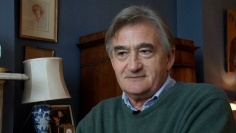LAURENCE REES: And the subsequent happy pictures of the liberation of Paris in August 1944 somehow make the Battle for Normandy look like a slight side-show, in contrast with what was happening in Eastern Europe. That’s the perception, isn’t it?
ANTONY BEEVOR: It is a perception and I think it’s a very false perception in many ways. I mean, that fighting was vicious, the killing of prisoners on both sides was probably greater in Normandy than it was in almost any other part of the war in the West, and when one thinks of North Africa that was comparatively chivalrous by comparison. But it is certainly true that there are all the images of the landing of D Day and then it just seems that somehow two months later we’re in Paris, isn’t that great? Well, it was a miracle once you had that battle of attrition. Then the breakthrough was possible. Patten kept on arguing that a really good punch would actually do it. Well, the Germans weren’t ready to be punched through in the way that Patten envisaged, and the battle of attrition, sadly, was probably necessary first. A lot of things could have been done better with the wisdom of hindsight, but for France itself it was a curious campaign because everyone imagined that the Battle of France would be the most awful, long battle which would destroy part of France, well, Normandy in fact became the martyr for France. The destruction in Normandy was appalling, but the rest of France was virtually saved and, from that point of view, I think that the French themselves have realised that Normandy was the sacrificial lamb for the rest of the country.
The Liberation of Paris
Antony Beevor

- Stalingrad
- Chuikov and Paulus
- Chuikov
- Tactics at Stalingrad
- Leadership at Stalingrad
- D-Day
- The Liberation of Paris
- Montgomery
- Warsaw and the Eastern Front
- Yalta and East/West relations
- Red Army atrocities
- Crete
- The greatest turning point of WW2
- The most mistaken decision of WW2
- The best decision of WW2
- The best leader of WW2
- The most overrated leader of WW2
- Why study history and WW2 in particular
 Twitter
Twitter




